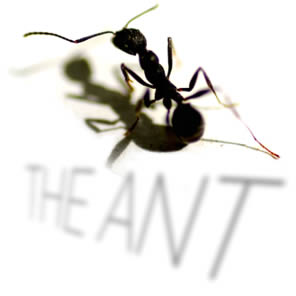




The Ant
(insect)
common black ant, garden ant, Lasius niger
Key features
As with all social insects, there are a number of different
castes comprising a complicated community within the
ants' nest. The workers are most common caste and
the ones that are most likely to be seen by the pest controller.
Males and queens are produced at certain times of the year and these are the winged individuals, the so-called flying ants, which are common on thunders days in summer. The workers of L. niger are about 2-5mm in length, almost exclusively black or black/brown in color although the bases of the antennae, the tarsi, and the leg joints have a yellowish colour.
The presumptive queens and males are larger in body size, 6.6-10mm and 3.5-4.7mm respectively,
again prominently black but o emergence from the nest they have wings.
The wings are lost by the female once mating has taken place and the males die shortly after mating.
Biology
a smaller starter nest beneath the soil. The queen rears the first brood of larvae within the nest, feeding them on saliva. These larvae mature then pupate to form the first cohort of worker ants. While she is rearing the first batch of larvae, the queen uses the reserves from her flight muscles etc as food. The colony then grows rapidly with the queen continuing to lay eggs which are tended and fed by the workers. The ants feed on nectar, seeds and small insects, aphid and coccid honeydew etc, and the nests can remain viable for many years. As mentioned above there are periods during the summer when the late forms are formed often in substantial swarms. Climatic conditions affect this since the males and females exploit the thermal currents to rise and mate in mid-air. Typically mating flights occur in August, following stormy weather. Very few of these fertilized queens survive to set up colonies.
Distribution
Northern Africa, North America, and carried to southern Africa.
Significance
The only indigenous species that commonly enters houses. L. is the most common ant in USA. Nests are typically found in soil but may be under paving stones and concrete. When ants have nested indoors, infestations may cause problems at any time of the year. In such circumstances, their nests are usually found in the insulation layer below a property.
The garden ant can pose a real problem as a nuisance pest. During foraging, workers may be found in domestic and industrial premises searching for sugary food sources. The mating swarms can also be a short-term nuisance.
Control
Accessibility to the nests may be restricted and yet this is the key to gaining control of the infestation. Following trails of the worker ants back to the nest should help to locate their position. Gel baits are now available for black garden ants. These rely on the worker ants picking up the bait and taking it back to the nest to feed the queen. Therefore baits should not be used in conjunction with residual sprays. Baits are best placed where the ants are foraging - in and around nest entrances, adjacent to ant trails and in the cracks and crevices between paving slabs, concrete foundations etc. Alternatively, residual insecticidal treatments can be applied in or around the nest. Barriers of insecticide can also be utilized around strategic points on the property to prevent foraging workers gaining access. Good hygiene so as to reduce attraction for ants is also important.
The Ant
(insect)
pharaoh's ant, Monomorium pharaonis
Key features
in length, with
the queen being larger between 3 and 4 mm long, while the males are around 3 mm. The coloration of the workers is light yellow with a darkish abdomen.The characteristic of the Pharaoh's ant appearance is the double 'waist' known as the pedicel, which in fact constitutes the first segments of the abdomen.
Biology
One of the significant features of the life cycle of the Pharaoh's ant is the fact that each colony has many nests and also many queens.
Each new queen lays around 300 - 350 eggs during her egg-laying spell and the eggs hatch in about a week. The first batch of larvae are tended by the queen while the subsequent generations are looked after by the workers of the colony. Worker ants are able to form satellite colonies, which lead to the spread of infestation. They remove the developing brood from an existing nest and form a new nest elsewhere. By their behavior to the feeding of this brood, they are able to produce worker, queen or male ants as required, Males and females are fully winged but they are rarely seen to fly.
Distribution
Originally a tropical ant will survive in centrally heated locations in temperate regions. Such exotic ants are known as tramp species.
M. pharaon is the most commonly encountered tramp species in the USA being found in domestic premises, hospitals, prisons, zoos, botanical gardens, food manufacturing premises etc.
Significance
The multi-nesting behavior of this species means that if one area of the building is infested, there is the likelihood of extensive spread throughout the building. Areas of high temperature and humidity are favored by Pharaoh's ants where they attack human foods such as fruit, jam, sugar, meat, etc. Because of there small size they can be a considerable nuisance in the food preparation premises, hospitals etc. There is evidence that the ant may be involved in the mechanical transmission of some disease-causing agents.
Control
The use of conventional insecticides against Pharaoh's ants is not recommended as this will almost certainly cause worker ants to form satellite colonies and thus actively spread an infestation deeper into the building.
Granular or gel baits are available for Pharaoh ant control. These should be laid where the ants are actively foraging and particularly with this ant species, treatment of adjacent properties may also be advisable.

THE ANT

